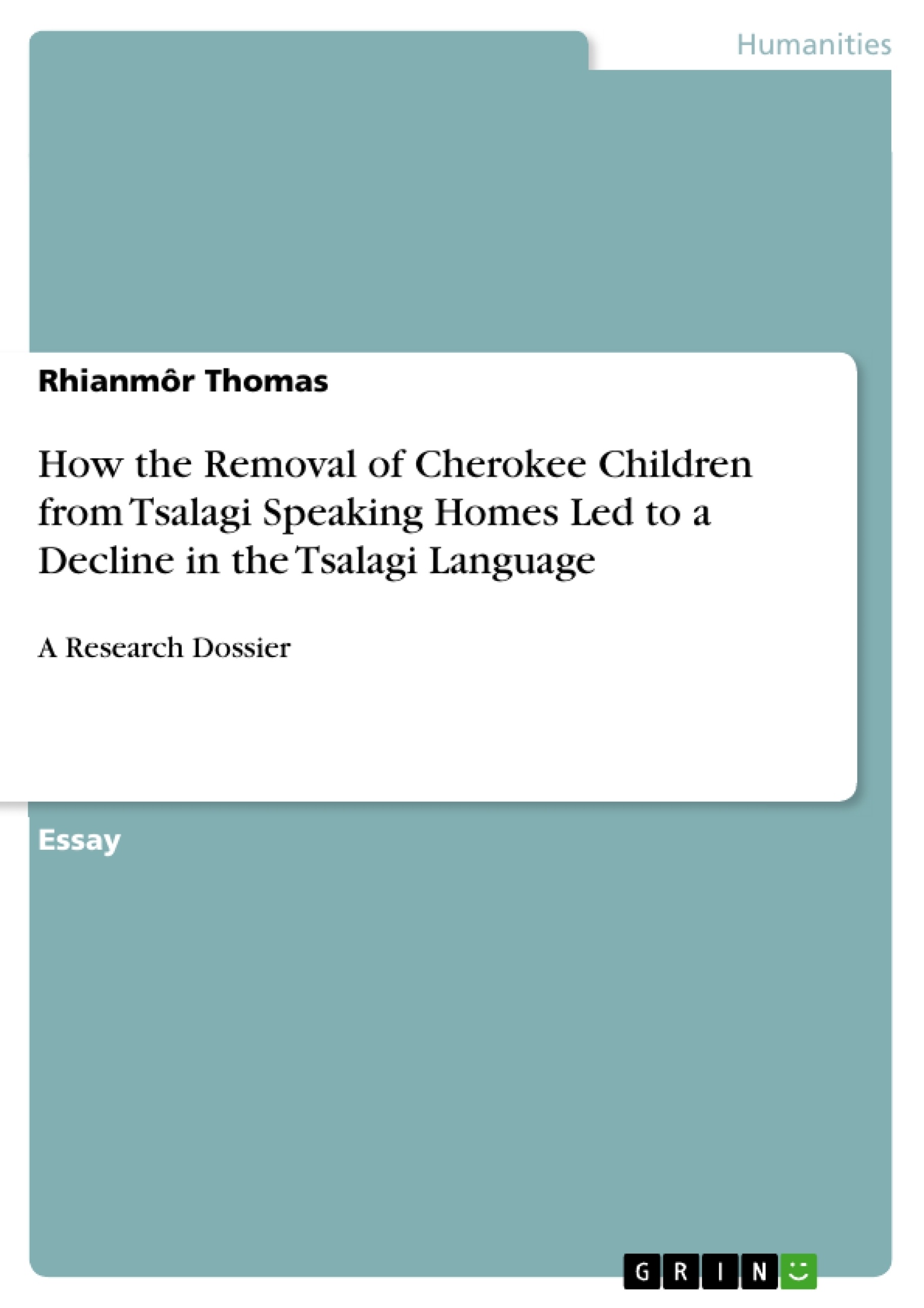An exploration of the decline of the Tsalagi language due to the remvoal of Cherokee children from their native speaking homes. Inculdes discussion of the Missionaries, Henry Richard Pratt and the Carlisle Indian Industrial School, Sequoyah and His Syllabary and the Effects and Decline in Language and the Solutions.
Table of Contents
- Introduction
- The Missionaries and "Civilisation"
- Henry Richard Pratt and the Carlisle Indian Industrial School
- Sequoyah and His Syllabary
- Effects and Decline in Language and the Solutions
Objectives and Key Themes
This project dossier aims to explore the historical context of the Cherokee Nation's interaction with westward expansion in the United States, focusing on the impact of missionary efforts and the Carlisle Indian Industrial School on Cherokee culture and identity. The text examines the policies and events that led to the displacement and assimilation of the Cherokee people.
- Westward Expansion and its impact on the Cherokee Nation
- The role of missionaries in the "civilizing" of Native Americans
- The Carlisle Indian Industrial School and its methods of assimilation
- The effects of cultural suppression on Cherokee language and traditions
- Resistance and resilience of the Cherokee people in the face of oppression
Chapter Summaries
Introduction: This introductory section sets the stage for the subsequent chapters by providing a brief overview of the westward expansion of settlers in the United States and its encroachment upon Cherokee territory. It highlights the conflict arising from Manifest Destiny and the disregard for treaties, laying the groundwork for understanding the subsequent forced assimilation and cultural suppression faced by the Cherokee Nation. The introduction briefly touches upon the key themes of the project, emphasizing the devastating impact of colonialism on the Cherokee people and their land.
The Missionaries and “Civilisation”: This chapter delves into the efforts of missionaries to "civilize" Native Americans, a process often intertwined with religious conversion and the suppression of indigenous cultures. The text explores the concept of "civilization" as defined by the American government and missionaries, contrasting it with Cherokee traditions. It discusses the establishment of missionary schools and their impact on Cherokee children, who were often separated from their families and forced to adopt American customs and Christianity. The chapter also touches upon the inherent racism and paternalism underpinning these "civilizing" efforts, showing how the concept was used to justify the removal of Native Americans from their lands.
Henry Richard Pratt and the Carlisle Indian Industrial School: This chapter focuses on the Carlisle Indian Industrial School, founded by Henry Richard Pratt, and its role in the assimilation of Native American children. It details Pratt's military background and his philosophy on education, which emphasized strict discipline and the suppression of Native American traditions. The chapter describes the harsh conditions experienced by the children at Carlisle, including the forced adoption of Anglo names and the prohibition of Native languages and customs. The systematic dismantling of Cherokee identity through this institution forms the core argument of this section.
Keywords
Westward expansion, Cherokee Nation, Manifest Destiny, missionaries, assimilation, Carlisle Indian Industrial School, cultural suppression, colonialism, indigenous rights, Native American history.
Frequently Asked Questions: Cherokee Nation and Westward Expansion
What is the main focus of this document?
This document provides a comprehensive overview of the historical impact of westward expansion in the United States on the Cherokee Nation. It specifically examines the roles of missionary efforts and the Carlisle Indian Industrial School in the cultural suppression and assimilation of the Cherokee people.
What topics are covered in the document?
The document covers several key themes, including westward expansion and its impact on the Cherokee Nation; the role of missionaries in attempting to "civilize" Native Americans; the Carlisle Indian Industrial School and its assimilation methods; the effects of cultural suppression on Cherokee language and traditions; and the resistance and resilience shown by the Cherokee people.
What is the purpose of the "Chapter Summaries" section?
The "Chapter Summaries" section provides concise overviews of each chapter's content. It outlines the key arguments and information presented in each section, offering a roadmap to the document's overall narrative.
What does the chapter on missionaries discuss?
The chapter on missionaries explores the efforts to "civilize" Native Americans, highlighting the often-forced religious conversion and suppression of indigenous cultures. It analyzes the concept of "civilization" as defined by the American government and missionaries, contrasting it with Cherokee traditions, and examines the establishment of missionary schools and their impact on Cherokee children.
What is the significance of the Carlisle Indian Industrial School chapter?
This chapter focuses on the Carlisle Indian Industrial School, detailing its role in assimilating Native American children. It discusses the school's founder, Henry Richard Pratt, his philosophy, and the harsh conditions experienced by children, including the suppression of Native languages and customs. The systematic dismantling of Cherokee identity is a core argument of this section.
What keywords are used to describe the document's content?
The keywords include: Westward expansion, Cherokee Nation, Manifest Destiny, missionaries, assimilation, Carlisle Indian Industrial School, cultural suppression, colonialism, indigenous rights, and Native American history.
What is the overall objective of this project dossier?
The project aims to explore the historical context of the Cherokee Nation's interaction with westward expansion, focusing on the impact of missionary efforts and the Carlisle Indian Industrial School on Cherokee culture and identity. It examines the policies and events leading to the displacement and assimilation of the Cherokee people.
What is included in the Table of Contents?
The table of contents lists the following sections: Introduction, The Missionaries and "Civilisation", Henry Richard Pratt and the Carlisle Indian Industrial School, Sequoyah and His Syllabary, and Effects and Decline in Language and the Solutions.
- Citation du texte
- Rhianmôr Thomas (Auteur), 2009, How the Removal of Cherokee Children from Tsalagi Speaking Homes Led to a Decline in the Tsalagi Language, Munich, GRIN Verlag, https://www.grin.com/document/208802



